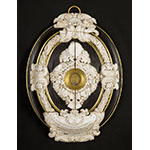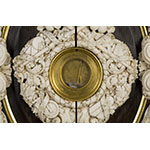Objective lens used by Galileo for many observations in 1609-1610. In 1610, he was the first to observe Jupiter's moons, which he called the "Medicean Planets." He announced his great discovery in Sidereus Nuncius [The Starry Messenger], published in Venice the same year. Galileo donated the lens of the telescope with which he made the discovery to Grand Duke Cosimo II. At a later date, the lens was accidentally cracked. After Galileo's death (1642) the lens was kept in the Guardaroba [Wardrobe] of Prince (later Cardinal) Leopold de' Medici. When Leopold died (1675), the lens was added to the Medici collection in the Uffizi Gallery. The collection remained there until 1793, when it was transferred to the Museo di Fisica e Storia Naturale. In the mid-nineteenth century, the lens was displayed in the Tribuna di Galileo with other Galilean memorabilia.
In 1677, the Medici commissioned Vittorio Crosten to build the ebony frame in which the lens has since been preserved.











